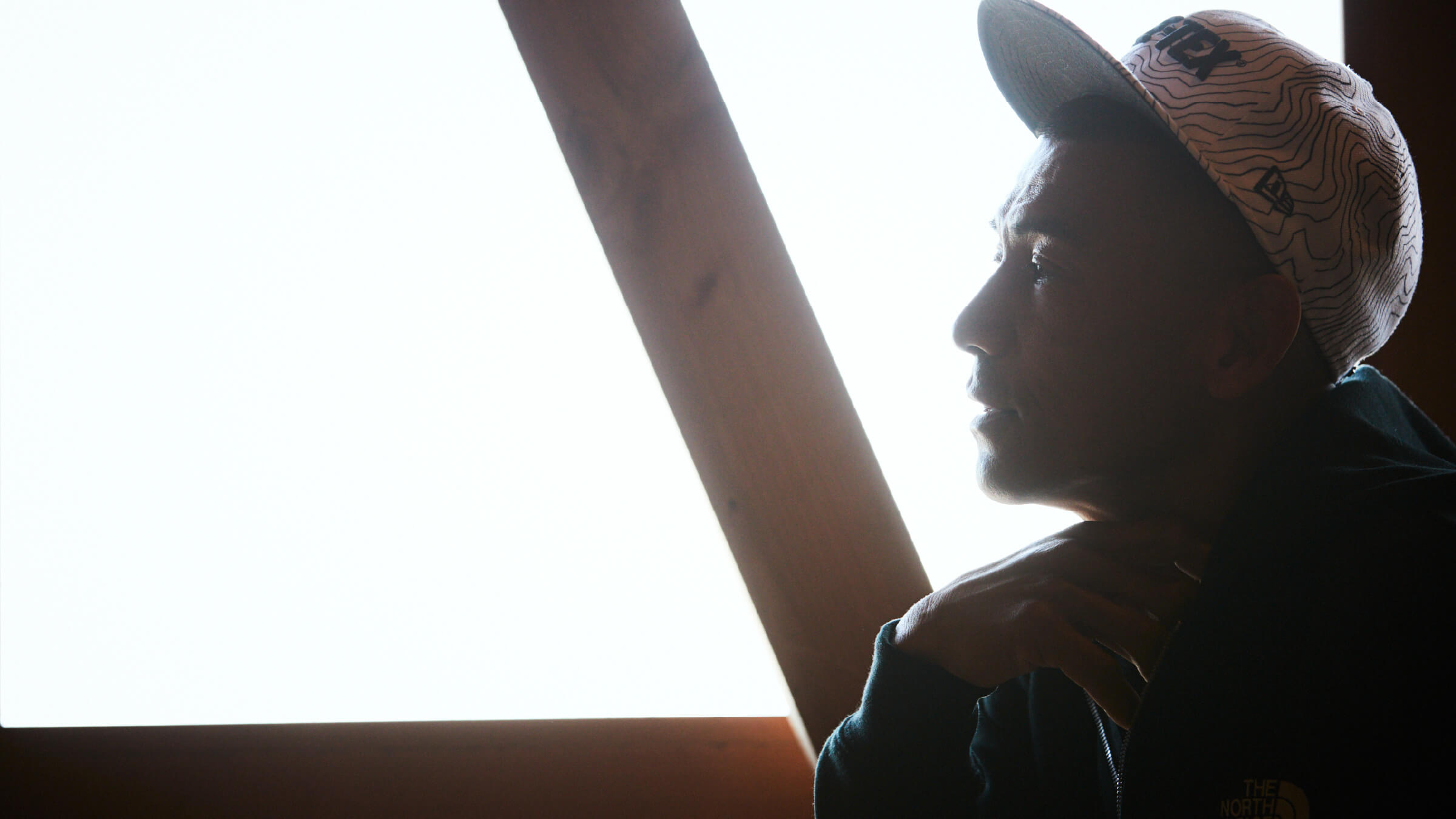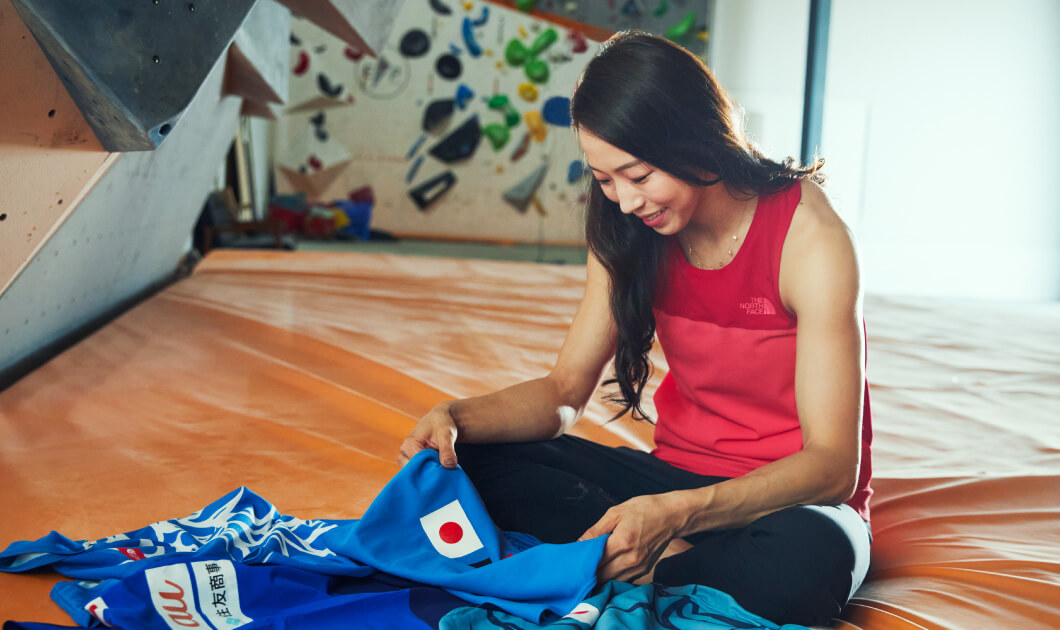
Competing with Someone Can Help You Grow
Aside from official events like the World Cup or Japan Cup, one of the biggest bouldering competitions in Japan is The North Face Cup (TNFC), launched in 2001. In 2020, its 19th year, TNFC was canceled due to the COVID-19 pandemic, and the outlook for holding the event in 2021, its 20th anniversary year, is unclear. But Yuji Hirayama, the competition’s founder, is not giving up. He has started working towards relaunching TNFC, even if a full-scale version cannot yet take place. Things are better for top-tier climbers who compete in events like the World Cup, but TNFC has become a place where general climbers who haven’t reached that level can develop their abilities, so I want to give those people something to aim for. First we’ll hold competitions at three or four venues, in 2021 and in 2022 I’d like to hold a full-scale relaunch.”

Hirayama has spent half his life developing his skills in climbing competitions. On the climbing scene, it was in the mid-1980s that events started to be held in a serious way as real competitions. Hirayama took up climbing right around that time. When he was 20, he moved to France in order to compete in events. He achieved recognition as a two-time World Cup lead climbing champion for the years 1998 and 2000. These successes were heartening to climbers in Japan and greatly influenced the development of the country’s climbing scene.
“I’m keenly aware that competing improved my climbing skills tremendously. Competing and going through various experiences with a wide range of climbers, I’ve discovered and absorbed a lot of things I hadn’t been aware of when I climbed on my own. Wanting to win and to grow are really basic human desires, so you naturally become very serious [in competition]. We do need this kind of setting. Being provided with occasions to compete is
very important for the development of climbers’ abilities. At any rate, it’s been frustrating not to be able to do that during the pandemic. I’m really eager to bring back that opportunity as soon as possible.”
TNFC Turns 20
A bouldering category was added to the Climbing World Cup in 1999. It was around that time that bouldering began to take off worldwide. The following year saw the launch in Japan of a bouldering competition held at Climbing Gym 7a, with Yuji Hirayama as chief route setter. From today’s perspective, though, it was a modest event. That was the era when route setters and staff were all volunteers and the few dozen participants were all acquainted with one another.

“During that period, I was participating in overseas events as an athlete. I saw several bouldering competit ions, but somehow I didn’t find them very interesting. I was thinking there should be a more appealing competition format, and this [bouldering] event happened to start just when I came back to Japan. It eventually evolved into TNFC. At the time, people hadn’t even decided exactly what a bouldering competition was supposed to be, so the line between climbers and staff was vague and there were fierce arguments—‘I want to do it this way’ and ‘No, this way is cooler.’ But I sensed that there was real excitement. Then I joined as a staff member, too, and together we began the work of creating our ideal event.”
At the time, Hirayama was already picturing the bouldering competition style prevalent today. In a big, splendid venue, the contest starts, together with music that creates a lively mood; a play-by-play announcer excitedly shouts out the athletes’ every move; and the performances have everyone in the country on the edge of their seats. Then the winners are praised to the skies… In Hirayama’s words, “I want to bring a party atmosphere to people’s living rooms through climbing.” Twenty years later, that idea is truly becoming a reality; at the time, though, such a future was a distant dream. To turn Hirayama’s mental image into reality, TNFC was launched in 2001.
The Koshien of Climbing
“At the time we didn’t have knowhow or sufficient funds, but everyone involved had tremendous enthusiasm about developing the climbing of the future. Twenty years later, the people who I talked and debated with about how to design bouldering competitions are now employed in important posts at the International Federation [of Sport Climbing], or working as route setters for big global events, or they’ve been the first to climb famous bouldering problems in Japan and other countries. The people who shared the same dreams in the past are the mainstays of the present. When I think about that, I get emotional—I feel like we might have made a contribution to the development of the world of climbing.”
“A contribution to the world of climbing” is a key phrase that Hirayama utters frequently when speaking about TNFC. One indication of this aim is the fact that a kids’ category was established early on in the history of TNFC. Today it isn’t unusual for primary school kids to
participate in climbing competitions; 20 years ago, however, there were very few juvenile climbers, and in any case the opportunities for them to compete were extremely limited. It could be said that TNFC was one of the earliest initiatives to provide a setting for a full-scale kids’ competition in Japan. Hirayama spoke about that objective.

“My own child was around kindergarten age then. We’d go as a family to an area with rock formations and play together there, but at the climbing gym there were no [climbing] problems that children could climb—and in any case, it wasn’t a place where you’d bring a kid to have fun. There were hardly any settings where children could do climbing. I wanted to create an opportunity for them to come in contact with climbing, and that led me to start a kids’ competition. Well, it was called a competition, but at first it was more like a game. It wasn’t the kind of event that required competitive drive. Personally, I think around junior high or high school age is a good time to start real competitive climbing. Before that, it’s much more important for kids to have experiences that are simply fun for them. We started the TNFC kids’ competition with that concept. But as we continued to hold events, the number of participants doubled and we received more and more requests to make
it a rigorous competition. So the kids’ class transformed into a competitive setting, too. Maybe the times evolved faster than I’d imagined.”
“I wanted to make TNFC the Koshien (National High School Baseball Tournament) of climbing.” This is another concept for TNFC that Hirayama often speaks of. The idea is that outstanding young climbers throughout Japan compete in events held in their own area. First they work hard to achieve good results in the local competition. Those who reach the top in their local event have the chance to compete in the annual finals, where they go up against rivals from all over the country. Winning or achieving superior results in the finals opens up the path to becoming a member of Japan’s climbing team—just as doing well in the Koshien opens up the path to becoming a professional baseball player. Based on this objective, TNFC became a nationwide event in 2009. A system was developed in which local events are held in different parts of
the country and winners are decided in the finals at the end of the season.
From TNFC to the World
“We want TNFC to be an opportunity to see and experience climbing, and at the same time we’d like it to be a place that shows the way to the kind of world you can find if you continue to pursue climbing. Enjoying different levels, savoring the joy of winning… You gradually move up, and what lies ahead is the chance to become a member of Japan’s climbing team. We wanted to make that path clearer, so we created the division system. We got the hint from the J.League (Japan Professional Football League).”

In the division system, classes are determined according to climbing level, and people who achieve excellent results in each class are allowed to participate in higher classes. In the past there were only about three levels—beginner, intermediate and expert—but the levels were subdivided further, so participants can experience the pleasure of winning in each level and there are more opportunities to enjoy moving up. The structure has expanded to 12 divisions, including 3 kids’ divisions.
This brings us to the present. The TNFC that began 20 years ago with a few dozen people is now a major event with a total of over 2,000 participants, held at 13 venues around Japan. During that time, many climbers—following the lead of Akiyo Noguchi, who won the TNFC in 2004 at the age of 14—have spread their wings from TNFC to the world. Having witnessed this history, what is Hirayama thinking today?
“Japan is now a powerhouse in the top tier of international sports climbing, and I’m proud that I may have had a role in that development. I think TNFC has grown to be an important event in the world of climbing in Japan, and I want to restart as soon as possible so that we don’t lose the momentum. On the other hand, in the year and a half that the flow has been suspended, the world and the climbing scene have changed greatly. I think 2021 has been an epoch-making year for climbing. Up to now the development of the climbing scene has been based on highly focused,
analytical thinking on the part of specialists, but I feel that, going forward, there will be a need for all of us to look at climbing from a wider perspective transcending that framework. TNFC may also be required to change along with the new age. While searching for that future, I’d like to create a new era again.”
Yuji Hirayama
Professional free climber. Born in Tokyo on February 23, 1969. Yuji Hirayama discovered climbing at the age of 15 and reached the peak of Japan’s climbing world while still a teenager. Since then he has been active as a top climber in America and Europe for over three decades. He is known as “the world-famous Hirayama” for a climbing style that has been praised as the most beautiful on the planet. In 1998, Hirayama became the first Japanese climber to earn an overall victory in the Climbing World Cup; and in 2000, he achieved his second World Cup overall win and rose to number one in that year’s rankings, reaching the global summit of climbing. Active not only in competitions but also in extremely challenging natural rocky terrains, Hirayama has created a worldwide impact and made way for previously unknown possibilities. In 2010, Hirayama realized a long-held dream in opening the climbing gym Climb Park Base Camp. In recent years he has appeared as a TV commentator for events including the IFSC Climbing World Cup.











